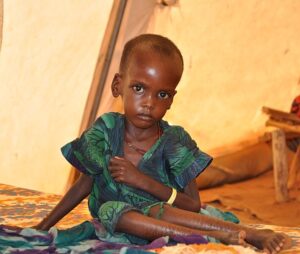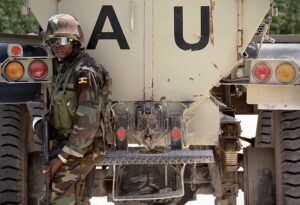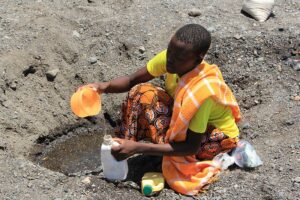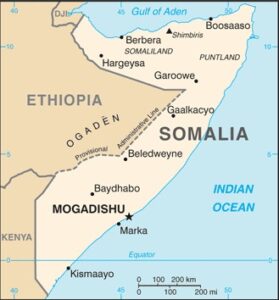Somalia
What
Since 1978, Somalia has experienced instability resulting in a humanitarian crisis. Over the years, numerous unsuccessful efforts have been attempted to stabilize the country.[1] Today, Somalia hosts over 38,000 refugees and asylum seekers, and more than 3.86 million internally displaced persons. [2]
Where
The Republic of Somalia is in the Horn of Africa. It shares a border with Ethiopia, Djibouti, and Kenya, and touches the Gulf of Aden to the north and the Indian Ocean to the east. Mogadishu, the capital city, is in the southeastern part of the country, along the coast of the Indian Ocean.
In 1991, northern forces declared an independent Republic of Somaliland in northwest Somalia. [3] Although not recognized by any government, Somaliland has remained stable, and leaders continue to try to establish a constitutional democracy. [4]
Puntland is a self-declared, self-governing autonomous state in the northeastern area of Somalia. There have been efforts to create a legitimate, representative government, and this has been met with civil strife. [5] There are border disputes between Puntland and Somaliland. [6]
Failed Governance System and Violence
In 1991, the Somali government was overthrown. [7] Failure between sides to agree on a new president led to warfare and lawlessness. Power struggles between warlords resulted in thousands of people displaced, injured, and killed. [8] From 2000 to 2006, attempts were made to set up a transitional government, engage in a peace process, establish an interim government and new constitution, and transition to a representative government. [9] [10] Militia violence continued, particularly in the south, from 2006 to 2009, between Islamist insurgents and Ethiopian troops against the government. [11] In 2009, Somalia’s parliament elected new members and a moderate Islamist as president. [12]
This transitional government continued to work toward national elections. [13] Violence re-erupted and a state of emergency was declared. [14]
In 2012, the first formal parliament in over 20 years was sworn in, and the first presidential election occurred since 1967. [15]
Insurgents, government forces, and foreign troops have destroyed the lives of civilians throughout the country, particularly in Mogadishu. Bombings and crimes against humanity have occurred, including violations such as indiscriminate attacks, killings, rape, use of civilians as human shields, and looting. Warlordism and violence continue. [16]

A malnourished Somali child in the Dolo Ado refugee camp in Ethiopia. Image courtesy of DFID – UK Department for International Development is unmodified and licensed under CC BY 2.0.
Drought, Famine, and Displacement
Decades of violence interrupted food production, and Somalia’s worst drought in 60 years began in 2010, [17] resulting in a UN declaration of famine in 2011. [18] Another extreme drought from 2015 to 2016 displaced over 615,000 people who became desperately food-insecure. [19] Prolonged drought, recurrent flooding, and long-term violence has caused crops to fail and food prices to skyrocket. [20] Aid agencies report that 4.3 million people in Somalia are currently food insecure. [21]
Fully 1.5 million people were internally displaced in 2023, with 40% displaced due to conflict. [22] Many Somalis who are displaced face serious abuse, sexual violence, forced evictions, and limited access to basic needs. [23] Nongovernmental organizations and UN agencies are prohibited in some areas. [24] Attacks on aid workers severely limit relief operations. The humanitarian crisis is fueled by ongoing conflict and frequent droughts and is directly linked to the climate crisis. [25]
Abuses Against Children
Girls who are internally displaced remain at risk of sexual and gender-based violence by both armed men and civilians. [26] All Somali parties to the conflict have committed serious abuses against children. [27] Children suffer disproportionately in this conflict, and they face forced recruitment as soldiers, rape victims, in forced marriage, and as victims in attacks on their schools. [28] Al-Shabaab troops, a clan-based terrorist and insurgent group, have reportedly used schoolchildren as human shields while fighting with government forces. [29] Al-Shabaab abducts children as soldiers, where victims face grueling and inhumane treatment and are often sent to the front lines with little training. [30] Abducted girls are used for domestic duties in camps and as sex slaves or are forced to marry male fighters. [31]
Somalia has the highest rates of female genital mutilation (FGM) in the world. [32] An estimated 98% of girls have undergone FGM, which causes severe health consequences and leads to higher likelihood of death during childbirth. [33]
International Response
Ethiopia
Ethiopian troops entered the Somali Civil War in 1996. In the early 2000s, Ethiopia supported a coalition of warlords and attempted to undermine Somalia’s government restoration efforts. Ethiopian troops launched incursions into various areas of Somalia to support militia and insurgent organizations and occupied Mogadishu for two years. The African Union and Arab League urged Ethiopia to pull out its troops. Ethiopian Prime Minister Meles Zenawi said that he would keep troops inside Somalia until “jihadists” were defeated. [34] As part of an agreement with opposition forces, Ethiopia withdrew its forces in 2009.

African Union presence in Somalia. Image courtesy of AMISOM Public Information is licensed under CC0 1.0.
African Union and United Nations
In 2007, Somalia appealed internationally for help due to ongoing conflict. [35] The UN Security Council authorized the African Union to deploy peacekeepers to Somalia in the African Union Mission in Somalia (AMISOM), which operated from 2007 to 2022. [36] Islamist leaders reacted by saying that they would treat foreign forces as invaders. [37]
United States and Kenya
The US has provided military support to Somalia’s transitional and federal government since the early 2000s. The US carried out air strikes in southern Somalia in 2007, targeting suspected Al-Qaeda members. The strikes resulted in civilian casualties and were still supported by Somalia’s then-President Yusuf. [38] In 2011, Al- Shabaab militants entered Kenya and abducted or killed five foreign tourists and aid workers. [39] In response to these events, combined with ongoing concerns about the large flow of Somali refugees into Kenya over 20 years, Kenyan troops entered Somalia. [40] After increased attacks on Kenyan civilians, the US killed Al-Shabaab’s leader, Ahmed Abdi Godane, in a drone strike in 2014. [41]
Most U.S. troops were removed in 2021, and the Department of Defense requested in 2022 to redeploy troops to Somalia to combat Al-Shabaab insurgents. U.S. military forces remain in Somalia today. [42]
Today
Crimes against humanity and conflict persist in Somalia today. Al-Shabaab continues to exploit the government’s limited ability to retain control. A humanitarian crisis remains, worsened by ongoing attacks against government forces, peacekeepers, and civilians. [43] Al-Shabaab’s three goals for Somalia are to remove foreign forces, disband the Federal Government of Somalia, and establish a “Greater Somalia” by joining all ethnic Somalis under strict Islamic rule. [44] The Somali government has failed to turn over Al-Shabaab cases from military to civilian courts and has carried out executions following military court proceedings, which violates the international fair trial standards. [45]

A woman digs for water in a dry riverbed in the Horn of Africa. Image courtesy of DFID – UK Department for International Development is unmodified and licensed under CC BY 2.0.
The UN and AU established a peacekeeping mission called the African Union Transitional Mission to Somalia (ATMIS). [46] This force became operational in 2022 and is a replacement of AMISOM. [47] Alongside ATMIS, the UN launched the United Nations Assistance Mission in Somalia (UNSOM). This mandate is set to end in 2026.
Sexual violence and abuses against children continue. A UNSOM report notes a significant increase in sexual and gender-based violence and that survivors of sexual violence are being killed. [48] Legal reform efforts to pass progressive anti-sexual violence legislation have stalled. The government has failed to implement child rights -complaint justice measures. Rights groups are concerned about legal attempts to lower the marriage age, which would allow children to marry once they have reached puberty regardless of age. This is projected to increase rates of child marriage, particularly among girls. [49]
Recurrent drought and flooding caused by the climate crisis result in widespread famine across the country. Almost half of Somalia’s population, at least 7.1 million people, face crisis-level food insecurity. [50] The climate crisis is a force multiplier of conflict, causing food insecurity, displacement, disease, water scarcity, poverty, and violence. [51]
Written by Rachel Hall Beecroft and Guled Ibrahim, J.D.; updated by Evelyn Middleton, November 2024.
References
[1] Lewis, I. M., & Janzen, J. H. A. (2024, October 30). Civil war in Somalia in History. Encyclopedia Britannica. https://www.britannica.com/place/Somalia/Civil-war
[2] UNHCR. (2024, September 1). Somalia. Global Focus | UNHCR Operations World Wide. https://reporting.unhcr.org/operational/operations/somalia#:~:text=Somalia%20hosts%20some%203.86%20million,mainly%20from%20Ethiopia%20and%20Yemen.
[3] World Peace Foundation. (2015, August 7). Somalia: Fall of Siad Barre and the civil war. Mass Atrocity Endings. https://sites.tufts.edu/atrocityendings/2015/08/07/somalia-fall-of-siad-barre-civil-war/
[4] BBC. (2024, January 2). Somaliland profile. BBC News. https://www.bbc.com/news/world-africa-14115069
[5] BBC. (2024, April 3). Puntland profile. BBC News. https://www.bbc.com/news/world-africa-14114727
[6] Mahmood, O. (2019, December 9). The various layers to the Somaliland-Puntland discord. Institute for Security Studies. https://issafrica.org/iss-today/the-various-layers-to-the-somaliland-puntland-discord
[7] Janzen, J. & Lewis, I. (2024, November 7). Civil war. Britannica. https://www.britannica.com/place/Somalia/Civil-war
[8] Janzen, J. & Lewis, I. (2024, November 7). Civil war. Britannica. https://www.britannica.com/place/Somalia/Civil-war
[9] Hansom, S. & Kaplan, E. (2008, May 12). Somalia’s Transitional Government. Council on Foreign Relations. https://www.cfr.org/backgrounder/somalias-transitional-government
[10] Tecle, F. (2006, May 22). Meles vs. Mengistu: The pot calling the Kettle Black. Sudan Tribune. http://www.sudantribune.com/spip.php?article16320
[11] Pham, J. (2011). State Collapse, Insurgency, and Famine in the Horn of Africa: Legitimacy and the Ongoing Somali Crisis. The Journal of the Middle East and Africa, 2(2), 153-187. https://doi.org/10.1080/21520844.2011.617238
[12] Gettleman, J. & MacFarquhar, N. (2010, March 11). U.N. Food Aid to Somalia Bypasses Needy. Student News Daily. https://www.studentnewsdaily.com/daily-news-article/u-n-food-aid-to-somalia-bypasses-needy/
[13] Aljazeera. (2010, September 21). Profile: Omar Abdirashid Sharmarke. Aljazeera. https://www.aljazeera.com/focus/2010/09/201092114544582381.html
[14] 2009 Country Reports on Human Rights Practices. (n.d.) U.S. Department of State. https://www.state.gov/j/drl/rls/hrrpt/2009/af/135976.htm
[15] BBC. (2018, January 4). Somalia profile – Timeline. BBC News. https://www.bbc.com/news/world-africa-14094632
[16] https://www.cnn.com/2013/07/10/world/africa/somalia-fast-facts/index.html
[17] Timeline: Breaking Down More Than A Decade of Drought in Somalia. (2022, October 22). Concern Worldwide US. https://concernusa.org/news/somalia-drought-timeline/
[18] Human Rights Watch. (2012, February 21). No Place for Children. Human Rights Watch. https://www.hrw.org/report/2012/02/20/no-place-children/child-recruitment-forced-marriage-and-attacks-schools-somalia
[19] UNHCR. (2017, May 12). Somalia Situation 2017 Supplementary Appeal January – December 2017. Reliefweb. https://reliefweb.int/report/somalia/somalia-situation-2017-supplementary-appeal-january-december-2017
[20] Ban Ki-moon, (n.d.). Famine in Somalia. United Nations Africa Renewal. https://www.un.org/africarenewal/web-features/famine-somalia
[21] CARE. (2024, October 10). Somalia food insecurity crisis – famine in Somalia. https://www.care.org/our-work/disaster-response/emergencies/somalia-food-insecurity-crisis/#:~:text=About%20the%20crisis%20in%20Somalia&text=An%20estimated%206.9%20million%20people,food%20shortages%20in%20the%20country
[22] UNCHR. (2023, September 24). UNHCR Somalia factsheet: September 2023 – Somalia. ReliefWeb. https://reliefweb.int/report/somalia/unhcr-somalia-factsheet-september-2023
[23] Amnesty International. (n.d.) Somalia 2023. Human Rights Watch. https://www.amnesty.org/en/location/africa/east-africa-the-horn-and-great-lakes/somalia/report-somalia/
[24] https://www.hrw.org/world-report/2020/country-chapters/somalia
[25] Abdullahi, A., Nor, F. & Abdullahi, A. (2024). Climate-induced humanitarian crisis, assessing the impact of recent floods and disease outbreaks in Somalia: short communication. Annals of Medicine & Surgery, 86(7), 3806-3807. https://doi.org/10.1097/MS9.0000000000002139
[26] UN News. (2021, August 5). Somalia: Call for urgent action following ‘alarming’ 80 per cent rise in sexual violence. UN News. https://news.un.org/en/story/2021/08/1097142
[27] Situation of Children in Somalia Alarming: New Report Details Staggering Levels of Grave Violations. (2022, June 14). Office of the Special Representative of the Secretary-General for Children and Armed Conflict. https://childrenandarmedconflict.un.org/2022/06/situation-of-children-in-somalia-alarming-new-report-details-staggering-levels-of-grave-violations/
[28] Somalia, the fate of Children in the conflict. (2012). How Does Law Protect in War? https://casebook.icrc.org/case-study/somalia-fate-children-conflict
[29] Somalia, the fate of Children in the conflict. (2012). How Does Law Protect in War? https://casebook.icrc.org/case-study/somalia-fate-children-conflict
[30] Somalia, the fate of Children in the conflict. (2012). How Does Law Protect in War? https://casebook.icrc.org/case-study/somalia-fate-children-conflict
[31] Somalia, the fate of Children in the conflict. (2012). How Does Law Protect in War? https://casebook.icrc.org/case-study/somalia-fate-children-conflict
[32] Female Genital Mutilation: A daily grim reality for girls in Somalia. (2023, February 6). ReliefWeb. https://reliefweb.int/report/somalia/female-genital-mutilation-daily-grim-reality-girls-somalia
[33] UNICEF. (n.d.). Child protection. UNICEF. https://www.unicef.org/somalia/child-protection
[34] UK Border Agency. (2008, October 3). Country of Origin Information Report – Somalia. Home Office UK Border Agency. http://www.refworld.org/pdfid/48eb15812.pdf
[35] Reuters. (2010, October 20). U.S. backs calls for more AU troops for Somalia. Reuters. https://www.reuters.com/article/us-somalia-usa/u-s-backs-calls-for-more-au-troops-for-somalia-idUSTRE69J6AE20101020
[36] AMISOM Background. (n.d.). AMISOM. https://amisom-au.org/amisom-background/
[37] United Nations. (2007, February 20). Security Council Authorizes Six-Month African Union Mission in Somalia, Unanimously Adopting Resolution 1744 (2007). United Nations. https://www.un.org/press/en/2007/sc8960.doc.htm
[38] CBS. (2007, January 8). U.S. Strikes In Somalia Reportedly Kill 31. CBS News. https://www.cbsnews.com/news/us-strikes-in-somalia-reportedly-kill-31/
[39] Throup, D. (2012, February 16). Kenya’s Intervention in Somalia. Center for Strategic & International Studies. https://www.csis.org/analysis/kenyas-intervention-somalia
[40] Throup, D. (2012, February 16). Kenya’s Intervention in Somalia. Center for Strategic & International Studies. https://www.csis.org/analysis/kenyas-intervention-somalia
[41] Whitlock, C. (2014, September 2). U.S. drone strike in Somalia targets al-Shabab leader. The Washington Post. https://www.washingtonpost.com/world/national-security/us-drone-strike-in-somalia-targets-al-shabab-leader/2014/09/02/2c833104-32a3-11e4-9e92-0899b306bbea_story.html?utm_term=.82e5df399b1f
[42] Faruk, O. & Anna, C. (2023, March 1). US increases military support for Somalia against al-Shabab. DefenseNews. https://www.defensenews.com/global/mideast-africa/2023/03/01/us-increases-military-support-for-somalia-against-al-shabab/
[43] Center for Preventive Action. (2024, October 15). Conflict with al-Shabaab in Somalia | global conflict tracker. Council on Foreign Relations. https://www.cfr.org/global-conflict-tracker/conflict/al-shabab-somalia
[44] Center for Preventive Action. (2024, October 15). Conflict With Al-Shabaab in Somalia. Global Conflict Tracker. https://www.cfr.org/global-conflict-tracker/conflict/al-shabab-somalia
[45] Human Rights Watch. (2024, January 11). World Report 2024: Rights trends in Somalia. Human Rights Watch. https://www.hrw.org/world-report/2024/country-chapters/somalia
[46] Panyo, & Panyo. (2022, July 7). About ATMIS. African Transition Mission in Somalia (ATMIS). https://atmis-au.org/about-atmis/
[47] Panyo, & Panyo. (2022, July 7). About ATMIS. African Transition Mission in Somalia (ATMIS). https://atmis-au.org/about-atmis/
[48] Human Rights Watch. (2022, January 13). World Report 2022: Rights trends in Somalia. Human Rights Watch. https://www.hrw.org/world-report/2022/country-chapters/somalia
[49] Africanews. (2024, March 31). Somalia parliament passes bill allowing President appoint PM. Africa News. https://www.africanews.com/2024/03/31/somalia-parliament-passes-bill-allowing-president-appoint-pm/
[50] UNSOM. (2022, June 19). Women in Somalia Live Through Pain of Displacement and Trauma of Conflict-Related Sexual Violence. United Nations Assistance Mission in Somalia. https://unsom.unmissions.org/women-somalia-live-through-pain-displacement-and-trauma-conflict-related-sexual-violence
[51] United Nations Climate Action. (n.d.). Five ways the climate crisis impacts human security. United Nations Climate Action. https://www.un.org/en/climatechange/science/climate-issues/human-security



